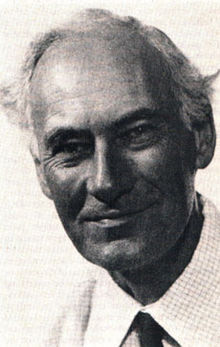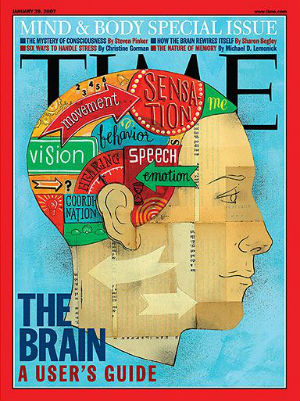‘Complicated Coke Machines?’ – or Something More?
By Neil Earle
(ED: here’s a summary of a paper I did at a 1990s UCLA class on Philosophy of Mind with a Christian conclusion I did not present.)
 J.J.C. Smart
J.J.C. SmartOne of the intriguing ideas from the world of neuro-science to explain the astonishing functionality of the human being is the proposition that we are merely end-result products of millions of years of development and are in fact no more than complicated coke machines.
A wise man said that most people mistake a colorful statement for a true one – and this brave title qualifies on that score.
It is important for those who doubt any notion of human beings as a special creation from the mind of a superior Creator to take a radical materialist approach: there’s not much to us really, so shed any notion of human special dignity or purpose behind the passing show.
Materialist Notions
J.J.C. Smart is an Australian philosopher who tries to move beyond the long-reigning Body/Spirit dichotomy or dualism inherent in the traditional Western outlook. Often called “Central State Materialists,” Smart and his supporters postulate that every type of mental state is identical with a physical state of the central nervous system (CNS). Our mental calculation of feeling pain, argues Smart, is nothing more than a disturbance in the nervous system. This strong correlation between mental states and nervous states leads him to advance a facet of what is called “the identity theory” – that mental states are directly equivalent to something else in our physical makeup, namely the reactions along the CNS.
Smart’s theory is boldly one-dimensional, monistic rather than Judaeo-Christian dualism. It raises a host of questions for philosophers of the mind. Some of them include: What are the evidences for arguing that Observer X can have a yellowish-green afterimage from a flash event, say, simply because X is responding to mechanical signals running along the CNS. Some would call this sheer reductionism – our reactions are all form our biological makeup. So why does Smart the materialist think his theory fits the evidence of our human functioning best? Some counter with the speculative question: Does Smart's theory imply that non-carbon-based beings on Mars (for the sake of argument) do not have minds simply because their inner functioning might be different than ours?
It’s all in the CNS, says Smart. Another philosopher described us humans as simply complicated coke machines. All our mental states – emtional, religious, positice and negative – are functions of superbly ordered nervous transmissions developed, presumably, along evolutionary lines. Even folk wisdom, argues Smart, deals in linked correlations – for example, the Morning Star and the Evening Star are both Venus:
There is, however, a more plausible example. Consider lightning. Modern physical science tells us that lightning is a certain kind of electrical discharge…Note that there are not two things: a flash of lightning and an electrical discharge. There is one thing, a flash of lighting which is described scientifically as an electrical discharge…The sense-datum, or rather the having of the sense-datum, the ‘look’ of lightning, may well in my view be a correlate of the electrical discharge. For in my view it is a brain state caused by the lighting.i
The Epi-phenomenal what?
Smart advances here a form of what could be called “dualist interactionism” – the brain state that I pass through after the experience of a severe lightening event is more a representation of the experience than a direct apprehension of it. My brain is “re-presenting” the experience to my mental processing. This is a clever way for Smart to dodge the emphatic claim of the realist school, that we can have direct experience of reality. Smart also cites the fashionable principle of epiphenomenalism – the notion that secondary causes are not linked, e.g. that train whistles do not make the machinery move, thus the Body causes the Mental State without help from a Mind-Body linkage. This is yet another analogy for his building on stimulus-response modes of theorizing.ii
Such correlations, claims Smart, show once again how the equation can be made between sense datum – a flash of lightning that leaves behind a yellowish-orange after image – and the CNS. In his theory, what is “going on” is a matter of sheer functionalism – brain processes tied to the nervous system. This is his first stage argument for the absence of any aesthetic, emotional or transcendental events outside the senses taking place in the brain.
Smart wraps up this first part with a repetition: “Again, ‘I see the Evening Star,’ does not mean the same as ‘I see the Morning Star,’ and yet ‘The Evening Star and the Morning Star are one and the same thing’ is a [workable] proposition…These sensations, I am arguing, are identifiable with brain processes.”iii
Once again, it’s all physical and all we are experiencing are mechanical inputs from the nervous system.
Something else has occurred as well. In defending his position Smart adopts a most convoluted-seeming form of circular reasoning. It goes like this: The property of having something going on inside me (i.e. having a yellowish-orange afterimage) is like what is going on when I have my eyes open, awake, and there is an orange illuminated in good light in front of me. In other words, the representation forms the basis of the mental image concept.
 A subject generating much discussion today.
A subject generating much discussion today.Objections, Please!
Jerome Shaffer spots the materialist Smart’s philosophical two-step. Shaffer points out that there is always something peculiar about sensory experiences (having a sensation of a yellowish-orange after-image). Such sensations have a self-revealing property that doesn’t seem to be accounted for in Smart’s model. They take on lives of their own. The experience has its own reality and can be overpowering on its own terms, as anyone who has skidded off an icy highway can attest. Furthermore, the word “like” which Smart employs in his analogizing introduces too broad and wide-ranging a host of categories to crisply explain so specificand comprehensive a theory as Smart is advancing. Yes, at the very least, Smart’s language needs tightening up before it can be a precise account of what is going on in explaining the after-image.
Smart’s theory also suffers from oversimplification. It is only a logical deduction from Smart’s stress on the role of the CNS in human perception to claim that would-be Martians – with different physiochemical makeup’s from ours – would not be able to have minds. Why is this so? Because, for Smart, mind activity is a function tied almost exclusively to the human nervous system. But wait, say some, this is a lot to lay upon the CNS and appears too narrow a conception to fit all the differing forms of life one could speculate upon as resident in the universe. In Star Trek I the crew of the Enterprise are called “carbon–units” by another life form. Smart’s critics say it is a form of “carbon-based chauvinism” to assert that Martians must have nervous systems exactly like ours.
So what are we left with in Smart’s theory?
Naïve Realism?
Smart has ingeniously handled the evidence from neuro-science which suggests an association between brain and mental states. Yet in his theory he has ended up with something that stands apart from traditional historical Newtonian-based realism into something like naïve realism. He attempts to finesse his critics with an ingenious pirouette around the premise that what is going on in our minds when we process an event is “something like” what is going on when we encounter a real event almost exactly corresponding to it.
Yet the phrase “something like” smacks of invoking the language of slipperiness and evasion. Nor has he dealt adequately with the Recognition Problem – the fact that we recognize the existence of some sudden pain or trauma quite vividly and clearly. One could say that just because our traumatic stress conditions in life leave such a painful after-effect inside us – the “rage of Achilles” on the death of his friend, for example – then we have folk evidence that what has happened transcends the wiring and circuitry of the CNS. The radical, violent and disturbing OUTPUT shows something more than the simple stimulus-response Pavlovian reactions of our nerves and inner functioning seems to be at work.
The coke-machine, conceiveably, could give you Sprite rather than Coke.
Something else as well. Psychiatrists and pastors know that simple unearthing the “why” of a stressor is not enough to restore a client to health. The elements of dread and fear which all humans experience are strong emotional after-effects of trauma. Revenge, too, is a complicated mental state in itself. For example, survivors of Auschwitz or a bitter marriage rarely forget it. There seems to be more at work here in what psychologists call the “reaction formation” than the fixation on valves, blood vessels and nerve endings. Else how answer why these "mental datum" have the ability to bother people decades after the event? More seems to be going on than simple CNS reactions carried along complex circuitry to the human mind. Smart’s theory could leave us advising holocaust victims, “Snap out of it. Your nervous system passed on that sense data years ago.” That simplistic application would not allow for the full complexity of what is going on in our minds.
 Mass murderers and shooters lift this issue from the realm of theory.
Mass murderers and shooters lift this issue from the realm of theory.“Who can explain it?”
Functionalism, with its focus on mental outputs as well as inputs, shows another missing dimension in Smart’s claims, as shown above. They might explain “revenge” reactions better but Ned Block shows weaknesses here as well.iv Our continuing stupefaction in the face of mass shootings and terrorist suicides shows something is missing in our analysis of what makes us human. Interestingly, some ancient texts seem to have charted the predicament before our bemused modern researchers. We have already quoted Homer and the rage of Achilles. But what about the Israelite prophet Jeremiah? He has been considered in our time to be a key figure in the movement of religio-historical ideas.
The existentialist Karl Jaspers called Jeremiah the “axial man” because of his clearly self-delineated role in moving religion from external to internal states – a philosopher of the human heart as much as anyone in antiquity. Jeremiah 17:9 is the prophet’s confession of what is going on inside his own mind, his own motivations and drives. “The heart is deceitful above all things and disparately sick,” he cried out, “Who can understand it?” Gordon McConnell states in The New Bible Commentary that for his era “the heart is the very basis of character, including mind and will in the Old Testament.”
Jeremiah is giving a painful self-analytical twist to the poignant question “who can know it?” a quandary presented in more positive form in Psalm 139. Here is another witness in more detail to how humankind cannot explain all about itself. In all our endeavors there seems to be more going on than meets the eye. For Jeremiah and the Psalmist an Outside Source had to reveals things about us that are buyried deep within. “It is not in man,” Jeremiah frankly confesses.
Nor is all this a mere speculative enterprise. After a mass shooting or similar tragedy we ask ourselves “Why?” “How could someone have done this?” While factors of individual psychology and family background play a large part we are still none the wiser, overall. There is what we could call the “Michael Caine Rule” from the part Caine played in a Batman movie. Bruce Wayne as Batman tried to analyze the motivations of the Joker, a fiendishly evil character. Caine answers dogmatically that his experiences teach him that “Some people just want to see the world burn.”
The human heart – who can know it?
The Coming Solution
If Romans 7 is to be believed, even the New Testament and the greatest saints of the Church cannot unravel all the complexities of human reaction formations, of human behavior. St. Paul confessed “I do not understand my own actions. For I do not do what I want, but I do the very thing I hate.” (v. 15). This is close to the Michael Caine comment but pointing to an Outside factor that might makes sense of it all. In Jeremiah words and reporting: “I the Lord search the heart and test the mind, to give every man according to his ways.”
We are so much more complicated than coke machines, to the point that intense searchers of themselves such as saints and prophets ultimately throw up their hands. This is a "moderate realism" position – there are things within us that are beyond us. Wise, experienced theologians have asserted that there are things we can see by the light of Nature (If it rains you get wet), others by the light of Grace (Evil things can work out for Good) and still others in the light of Eternity (“God knows the way” – Jeremiah). Paul followed up on this with his assertion that one day, in God’s good time, “we shall know fully, even as we are known” (1 Corinthians 13:12).
Perhaps St. Augustine had it right centuries ago: “You made us for yourself, and our heart is restless until it finds rest in you.”
i. J.J.C. Smart, “Sensations and Brain Processes,” in David M. Rosenthal (ed.) The Nature of Mind (New York: Oxford University Press, 1991), p. 171.
ii. Simon Blackburn, The Oxford Dictionary of Philosophy (New York: Oxford University Press, 1996), p. 122.
iii. J.J.C. Smart in The Philosophy of Mind (New York: OUP, 1991), p. 172.
iv. Ned Block in The Nature of Mind, pages 213-215.